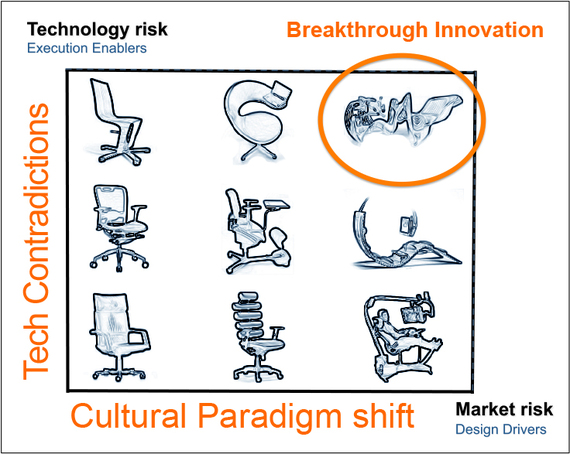One is never wrong until one comes to the realization of that fact. All of us operate with a certain amount of unexamined and unquestioned assumptions. Fortunately our Western society promotes such a diversity of assumption-based opinions that we are free and have the liberty to pursue our individual perception of happiness. It is only when contradictions pop up and conflicts of interest occur within our beliefs that we first try diplomacy and if that fails, we take up arms and go into battle.
What makes breakthrough innovation such a challenge is that it requires realizing, examining and concurrently questioning assumptions along two dimensions, market (driver) and the technology (enabler). The best outcome of this effort would be a potentially unknown risky business opportunity and the worst outcome - complete ruin. So how does this relate to all the talk about assumptions?
An innovation is a technical invention applied to an existing or new user need. An invention occurs when someone resolves a physical or technical contradiction, caused by an apparent contradiction rooted in an unquestioned assumption. A new need, on the other side, arises when a paradigm takes place, which is a change in our basic assumptions. So breakthrough innovation is making new assumptions along technology and market lines at the same time. How does one accomplish this?
Comprehension phase
First one has to want to change assumptions and learn new ones or get real facts. For understanding the situation, switching between diverging and converging questioning has proved to increase performance.
Observation phase
Then one requires new information and/or experience. It is important to gather a broad understanding as well as a deep understanding of domains far apart from each other, since cross pollination of closely located domains results in incremental innovation and become more breakthrough the further apart these domains are located.
Define perspective phase
Define a point of view and set a direction. The direction has to be new, inspirational, sticky and achievements measurable.
Ideation Phase
Having brought new focus, assumptions and knowledge to the party, the next step is to synthesize design concepts. Here, incremental concepts come easy, they are old ideas hidden in the attic of the brain and/or extrapolations of known concepts. The real challenge and game changer is to synthesize the breakthrough concepts.
This happens by first conducting intense vertical thinking (analytical thinking), to understand cause and affect relationships, followed by lateral thinking, using analogies and associations to explore new connections. Following this is a period of incubation, which helps the team members' thoughts to become un-fixated and then new insights percolate and one can begin to experience an "Aha" moment.
Prototype & testing phase
Following the synthesizing of a breakthrough concept, the testing of these concepts is, by nature, more critical than ever, since the solutions are not just a simple extrapolation from known concepts. Multiple and rapid prototyping iterations, validating the technical as well as the market aspects is key to creating a good fit between these ideas.
How does one recognize that one may have a breakthrough innovation? When everybody laughs or at least smiles about that "far out" idea. Breakthrough innovations initially appeal to only the fifteen percent of the population that comprise the innovators and early adopters. Creating acceptance for the breakthrough innovation concept now becomes critically important.
As the saying goes, "Ninety-five percent of all conflicts are due to misunderstandings" but conflicting ideas are exactly what are needed to re-examine the underlying assumptions that can then be explored to create new paradigms. Consensus is the death of new ideas, so let's agree not to agree and instead create truly breakthrough innovations.
